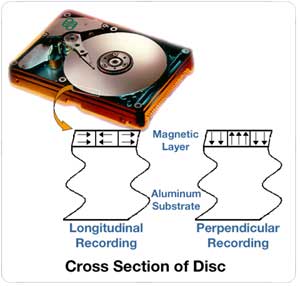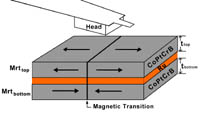High Density Storage Technologies; Pixie Dust and Perpendicular Recording
by Purav Sanghani & Kristopher Kubicki on July 19, 2005 2:08 PM EST- Posted in
- Storage
Samsung, Hitachi, Seagate, Toshiba, Fujitsu. Five names in the computing industry we have come to know as leaders in storage devices through their various technologies have come to a single conclusion: Hard disk storage technology needs an innovation. That innovation, for now, might be perpendicular recording; a method of storing information many have been talking about for a few years now. Only recently has anyone implemented this into a physical, real product but we'll get into specific names and products later. For now, let's take a look at what perpendicular recording really is and how it works.
Current hard disk drive technology allows us to store as much as 133GB on a single platter. Seagate's 7200.8 series Barracuda drive utilizes three of these platters to produce a 400GB drive which is the first and only drive to make use of the highest density platters to date...when it comes to the linear recording method of course. The limit to how much data we can fit on a single platter is quickly approaching. We can only cram so many bits on to this magnetic media until superparamagnetism begins to kick in.
Webopedia.com states:
When the areal density -- the number of bits that can be stored on a square inch of disk media -- of a disk medium reaches 150 gigabits per square inch, the magnetic energy holding the bits in place on the medium becomes equal to the ambient thermal energy within the disk drive itself. When this happens, the bits are no longer held in a reliable state and can "flip," scrambling the data that was previously recorded.
The scrambling happens because of the proximity of each bit and this keeps us from manufacturing reliable hard disk drives with areal densities greater than 150Gbpsi (Gb per square inch).
Webopedia.com also says:
Because of superparamagnetism, hard drive technologies are expected to stop growing once they reach a density of 150 gigabits per square inch.
Perpendicular Recording
Traditionally with linear recording method each bit is written side by side on a flat surface of the platter. To create higher density platters, manufacturers have to shrink these bits down to smaller sizes to be able to double hard drive sizes every 18 months or so. It is obvious that the bits can become crammed resulting in the superparamagnetism phenomenon. What perpendicular recording does is it records, or magnetizes, bits vertically through the platter instead of horizontally which efficiently conserves surface area which, in turn, results in the effective doubling of the areal density of the platter.

The phenomenon of supermagnetism can still occur with this technology but it is not yet known what the limits are of devices using perpendicular recording. We'll just have to wait and see what the R&D divisions of our beloved storage manufacturers can come up with, but until then, perpendicular recording has a bright future...right now.
On June 8, 2005, Seagate Technology was the first to introduce the world's very first hard disk drive using the perpendicular recording method; the Momentus 5400.3 2.5" notebook series lineup. Though the 5400.3 line will have various size options, the 160GB model will be the first one to use the perpendicular recording method.

The new Momentus line will be released by the winter season and we also hope to see perpendicular recording implemented in desktop drives just as quickly. But is perpendicular recording the only way we can increase density?
Pixie Dust
Taking a look back to past advances in storage technology, many of us can remember back when IBM first introduced "Pixie Dust" technology which promised to increase platter densities by at least a multiple of 4. "Pixie Dust" is just a special project name given to the antiferromagnetically-coupled media (AFC) technology because of the highly effective nature of the layer of ruthenium used.
AFC technology consists of a layer of the element ruthenium which is 3 atoms thick and positioned between two magnetic layers. For those interested in what the element ruthenium is:
Name: Ruthenium
Symbol: Ru
Atomic Number: 44
Atomic Mass: 101.07 amu
Melting Point: 2250.0 °C (2523.15 °K, 4082.0 °F)
Boiling Point: 3900.0 °C (4173.15 °K, 7052.0 °F)
Number of Protons/Electrons: 44
Number of Neutrons: 57
Classification: Transition Metal
Crystal Structure: Hexagonal
Density @ 293 K: 12.2 g/cm3
Color: silveryRuthenium is a hard, white metal. It does not tarnish at room temperatures, but oxidises in air at about 800°C. The metal is not attacked by hot or cold acids or aqua regia, but when potassium chlorate is added to the solution, it oxidises explosively.
- www.webelements.com
The two magnetic layers act against each other on either sides of the ruthenium layer, not pushing each other away, but rather having opposite force along the layer of ruthenium. As the head of the disk moves from bit to bit it detects the change in direction of the magnetic pull of each of the layers. So with two magnetic layers on either side of the thin layer of ruthenium, the bit fields can be made smaller and still maintain their strength and resistance to superparamagnetism.

AFC was first used in IBM's 2.5" Travelstart notebook drive and when Hitachi took over IBM's storage division, they took over AFC technology also. Currently, Hitachi GST uses AFC media to manufacture its Deskstar 7K400 400GB desktop drive.
This "Pixie Dust" technology will definitely help Hitachi keep away from using the perpendicular recording technology for a while but when superparamagnetism starts kicking in, they will have to succumb to newer, more improved means of recording on magnetic media.
Samsung, Fujitsu, and Toshiba also have perpendicular recording in their plans and we should expect to see product introductions from them in the near future. We will definitely keep you updated on any new introductions and releases of products that make use of these new high density technologies.










13 Comments
View All Comments
Houdani - Wednesday, July 20, 2005 - link
Just a minor correction in the paragraph after the first weboepedia quote. Change the "GB" in this line to "Gb" since we're talking about bits, not bytes.>> "...greater than 150Gbpsi (GB per square inch)."
Oh, and, um, yeah, what patentman said. Uh huh, uh huh.
Seriously, I applaud your knowledge. Dang! Nice contribution.
patentman - Tuesday, July 19, 2005 - link
All of this stuff has been long known. I used to work at the U.S. Patent and Trademark Office as an Examiner in the Art of Magentic Recording, and applications directed towards this sort of technology have been filed for quite some time (perpendicular media application were filed as early as 1990; AFC media as early as the mid 90's).Lots of stuff has been done to improve perpendicular media over the years. For example, alloying elements and oxides have been introduced into the recording layer so as to separate the grains from one another, thereby preventing intergranular eachange coupling, which reduces storage capacity; Higher coercivity alloys (coercivity being "the magnetic energy holding the bits in place on the medium") have been developed (albeit expensively, as they contain relatively high concentrations of rare elements such as platinum; and heat treatments have been developed to improve the ordering of the grains within the alloy.
The so called "keeper layer" perpendicular media dicussed above (see the diagram above which lists a "soft" layer under the recording layer). In keeper layer media, a "soft" magnetic layer is placed under the recording layer (either directly in contact with or spaced from the recording layer by an interlayer, which may either couple or decouple the soft magentic layer to the recording layer), in an attempt to improve the orientation of the magentic domains perpendicular to the surface of the media (In reality, the domains in perpendicular media are not oriented 90 degrees to the surface of the substrate as shown. Rather, they are ordered at an angle to the substrate). This keeper layer does, in some instances, improve perpendicular orientation, but, as far as I know, to date no one has been able to overcome the noise problem created by the presence of the soft magnetic layer (noise, in that the fies generated by the soft magentic layer interferes with the field generated by the magentic head, thereby reducing the resolution, for lack of a better word, of the head.).
While improving storage density of magentic media is an interesting problem, I think a more interesting (and difficult) problem in magnetic recording is once we are able to produce a media capable of that storage density, how will we read or write to it? Improving the theoretical storage capacity of a disk is one thing. Overcoming the resolution problem that is presented by reading and recording magnetic fields at that scale is another. In other words, theoretical density is one thing, realized density is another.
goku21 - Tuesday, July 19, 2005 - link
Very interesting read, but I wonder what sizes could be achevied(sp?) if both methods were used to create a hard drive.